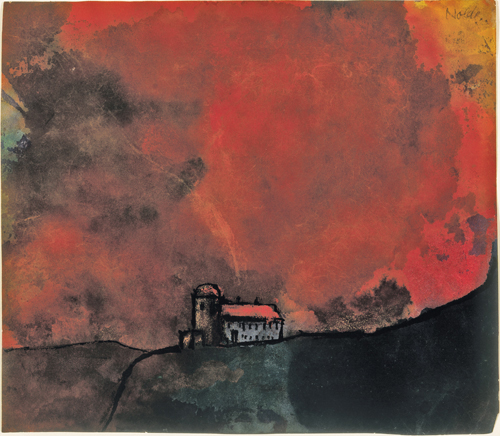An Expressionist Landscape for Fall: Emil Nolde
Let’s celebrate the official start of autumn with a beautiful little landscape by one of my favorite German expressionists: Emil Nolde. German expressionist landscapes were a big influence on my own painting when I was in school, so imagine my delight when I uncovered this little treasure while cataloging new image acquisitions from the awesome Buffalo AKG Art Museum in New York state!
Nowadays, we are accustomed to abstraction in art. However, not even 80 years ago a lot of the public had trouble with abstract art. I totally do not understand how such a beautiful use of color could be considered offensive, but before World War II (1939–1945), abstraction was under fire in some parts of Europe as well as being shunned in America. Weird.
 |
| Emil Nolde (1867–1956, Germany), Romantic Landscape with a Fort, ca. 1944–1945. Ink and watercolor on paper, 6 1/8" x 7 1/8" (15.87 x 18.41 cm). Albright-Knox Art Gallery, Buffalo, NY. © 2011 Estate of Emil Nolde/Artists Rights Society (ARS), New York. (AK-929noars) |
Expressionism in northern European art of the early 1900s was an offshoot of art movements in the late 1800s that emphasized romanticism, expressive color, or symbolic (rather than representational) subject matter. The objective in expressionist work was to impart the artist’s feelings about the subject and to elicit an emotional reaction from the viewer.
Nolde is a unique figure among the expressionists. Born in northern Germany near the Danish border, Nolde initially studied woodcarving in Berlin. He studied painting in Munich, and eventually in Paris from 1899–1900, where he came under the influence of the colors of Impressionism. Armed with this bright palette, he returned to an intrinsically German style influenced by Gothic art, featuring emotionally charged subjects in bright color with jagged, often distorted forms. He urged other artists to reject some aspects of western tradition in space and form, and embrace art from non-western cultures, such as African masks and Oceanic art.
In 1906 Nolde was invited to join the German expressionist group Die Brücke in Berlin, a group which Vasily Kandinsky characterized as expressing “inner necessity” in their painting. Nolde left the group a year later, preferring to follow a personal expressionist style. His works featuring figures reflected the influence of non-western masks, while his use of color was an exaggeration of the impressionist palette, and a reflection of the French Fauves’ use of non-local color on forms.
Nolde was a passionate believer in the superiority of the German people, and had a fervent affection for the land. He joined the Nazi party in the 1920s. However, by 1934 the Nazis considered his art too experimental and non-German and he was forbidden to exhibit. His paintings were part of the massive exhibition in 1937 (which included many of the expressionists and also Bauhaus artists) put on by the Nazis called Degenerate Art. The Nazis preferred a perverse type of social realism that extolled patriotic values of the German people through genre scenes and allegories. During World War II, Nolde, in self-imposed exile within Germany, produced only landscapes and floral still life paintings
This little landscape demonstrates Nolde’s love of his native land, expressed in the realm of pseudo fantasy. The brilliant color and vibrant movement of the surface are characteristic of his work throughout his life.
Activity: Ask students to create a painting about a memory related to weather. Have them choose warm or cool colors to dominate the painting depending on the mood they want to show.
Correlations to Davis programs: Explorations in Art Grade 1: 4.21; Explorations in Art Grade 2: 1.4; Explorations in Art Grade 3: 2.12; Explorations in Art Grade 4: 1.5, 4.22; Explorations in Art Grade 5: 4.20; A Personal Journey: 5.1; A Global Pursuit: 8.1, 7.3, 6.2; Exploring Visual Design: 4, 5, 6; The Visual Experience: 16.6; Discovering Art History: 14.1

Comments